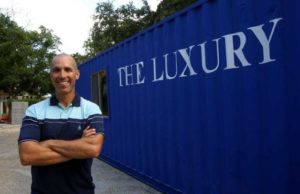Andrew Weismann will soon be opening up The Luxury on the banks of the new northern Riverwalk expansion. I’m looking forward to riding my bike up and checking out the place as well as receiving a discount for riding. This looks to be a wonderful addition to River North.
This article was recently in the Express-News and was written by Valentino Lucio and photographed by John Davenport.
Cargo containers used for new restaurant
Name belies new eatery — it’ll be made of cargo containers.
By Valentino Lucio
vlucio@express-news.net
Cargo containers aren’t just for shipping freight anymore. San Antonio chef and restaurateur Andrew Weissmann is using them for his newest restaurant, The Luxury.

Restaurateur Andrew Weissman will be opening a new restaurant on the banks of the San Antonio River called The Luxury that will be using cargo containers as buildings and landscaped patio areas for its guests to enjoy. Located at Jones and Avenue B near the San Antonio Museum of Art, Weismann plans on having spit roasted pigs and goats, burnt end barbecue sandwiches and an array of comfort foods.
Weissman, the owner of Il Sogno and The Sandbar restaurants at the Pearl Brewery, anticipates opening his newest venture next month. The eco-friendly hangout is situated at the corner of Jones Avenue and Avenue B, across the San Antonio River from the San Antonio Museum of Art.
It’s a departure from the high-end eateries that Weissman is known for and will feature a casual, family-friendly atmosphere, an inexpensive menu and outdoor-only seating where patrons order drinks and food from the various cargo containers.
“Calling it The Luxury would be like a play on words,” he said. “It’s the most casual of restaurants but with a kind of highfalutin’ name.”
The original design for the restaurant incorporated the use of airstream trailers. But those plans were abandoned because of space issues and the high cost associated with retrofitting the trailers, which was about $60,000 each. Plus, a city ordinance wouldn’t have allowed alcoholic beverages to be served there because the trailers are considered mobile, the chef said.
To bypass those issues, Weissman decided to use the brightly colored shipping containers, which provided more space, cost less to retrofit and allowed him to sell alcoholic beverages.
“It was a good way to try to repurpose these containers,” Weissman said. “There’s over a million of them floating around the country; they’re stacked in yards. I just thought that it would be a green way to do stuff.”
Initially, the restaurant will incorporate four 320-square-foot containers for bathroom facilities, office and storage, a kitchen and a beverage car. Two of the containers stand alone, but the office component is stacked on top of the kitchen in an L-shape. Later, Weissman wants to add other containers, including one for use as a live-music performance stage.

Chef Andrew Weissman will soon open his newest restaurant, The Luxury, that will operate out of multiple shipping containers along the northern stretch of the San Antonio River. Photo: Courtesy Douglas Architects / SA
Two arched entryways will provide access to the restaurant from the street and the river. Right now, the land is nothing more than a concrete lot, but landscaping is expected to be complete in the next week or two.
Metal glider chairs and tables with colorful umbrellas will be scattered around the outdoor space for patrons to use. Awnings will extend from the containers for added shade and a pit will be situated near the center of the property for open fire roasting. There will even be a bocce ball court.
Parking will be limited to about a dozen spaces. To promote alternative modes of transportation, Weissman said he’ll offer discounts for patrons who walk or bike to the restaurant.
The menu will be eclectic, offering an array of locally sourced comfort foods such as whole roast pig and goat, barbecue sandwiches, meatloaf and bread pudding. There will be a barista and sommelier on staff to help with the extensive drink list that features espresso, beer and wine, which will be served from a tap.
Andrew Douglas, president of San Antonio-based Douglas Architects, the firm that designed the project, said that modular developments are becoming popular. More people are looking to shipping containers as a quick and less expensive alternative for residential and commercial spaces.
“It’s a growing idea because there’s an excess of containers all over the world,” Douglas said. “Because they’re modular, there’s different, creative ways they can be used on almost any site. And if it’s done right, it’s cool-looking.”
With less than half an acre to work with, Frank Pakuszewski, principal for 1836 Asset Development, the project manager for The Luxury and the nearby 1221 Broadway apartments, said that using containers there was more efficient than having to construct a new structure.
“The challenge of infill development is that you’re already in an existing framework, and you have to adapt,” he said. “This is a really great adaptive use for shipping containers, and I honestly think it will get people to think about how they can be used. … Who knows what we’ve started, but it’s a great start.”
Link to the article on mysa.com:
http://www.mysanantonio.com/default/article/Cargo-containers-used-for-new-restaurant-1446434.php
